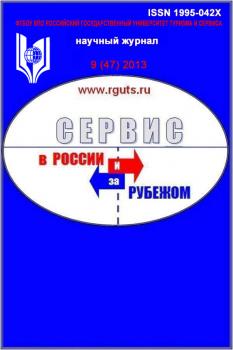The article presents an analysis and systematization of the central organizational and economic principles of design, development and improvement (arrangement) of suburban (neighborhood) walking trails, based primarily on international experience due to the very weak development of the suburban trail segment in Russia and almost complete absence of Russian scientific and practical studies in this field. The nearest concept to suburban trails, which received some attention (in terms of aspects) in the Russian scientific literature, is the "eco and local history trail", which is not sufficient from the point of view of the needs of practice. First of all, the work reveals in detail the multidimensional specificity of suburban walking trails, including such factors as thematic focus, tourist motivation, combination with suburban passenger rail transport, influence on local residents and other stakeholder groups, including through increases in the value of real estate, safety, importance for health and social well-being, correlation with other objectives of infrastructural development of suburbs. Further, the article highlights the role, significance and international experience in the arrangement and improvement of trails, including both road-engineering aspects and informatization. The next section illustrates international experience in route integration of suburban walking trails with suburban railway and bus transportation. The article also touches upon the aspects of economic justification and rationale for expanding the segment of suburban walking trails as a public good (primarily as a catalyst and multiplier of tourist activity in the region), as well as certain aspects of differentiated marketing strategies, along with the principles of sustainable development and a remarkable potential for implementing volunteer programs. In conclusion, the author suggests an extensive list of problems and thematic areas for prospective studies of suburban walking routes, emphasizing an extreme need to form a range pf scientific and scientific-practical works in order to conceptually and methodologically explore the segment of suburban walking trails in Russia.
hiking, walking, walking trail, hiking route, suburban trails, neighborhood trails, trail design, recreational walking, railway transport, suburban transportation, sustainable tourism, regional tourism
1. Il'kevich S.V., Saharchuk E.S. Ekonomicheskie aspekty ustoychivogo razvitiya turizma v re-gionah Rossiyskoy Federacii // Vestnik Associacii vuzov turizma i servisa. 2014. №2. S. 4-17.
2. Luzhkova N.M. Geoekologicheskiy podhod k obustroystvu peshih trop na OOPT federal'-nogo urovnya (na primere Baykal'skogo zapovednika) // Geografiya i prirodnye resursy. 2016. №1. S. 70-79. DOI:https://doi.org/10.1134/S1875372816010078.
3. Pedosyuk Yu.F. Problemy formirovaniya bezbar'ernoy sredy dlya razvitiya dostupnogo turizma // Vestnik RMAT. 2014. №3. S. 29-34.
4. Sviridchuk G.P. Razmeschenie ostanovochnyh punktov passazhirskih poezdov v bol'shih go-rodah i gorodskih aglomeraciyah // Vestnik universiteta. 2017. № 3. S. 83-86.
5. Agamirova Ek.V., Agamirova El.V., Lebedeva O.E., Lebedev K.A., Ilkevich S.V. Methodology of estimation of quality of tourist product // Quality - Access to Success. 2017. Vol.18. №157. Pp. 82-84.
6. Arneberger A., Eder R. The influence of green space on community attachment of urban and suburban residents // Urban Forestry & Urban Greening. 2012. №11. Pp. 41-49. DOI:https://doi.org/10.1016/j.ufug.2011.11.003.
7. Asabere P.K., Huffman F.E. The Relative Impacts of Trails and Greenbelts on home Price // The Journal of Real Estate Finance and Economics. 2009. Vol. 38. Iss. 4. Pp. 408-419. DOI:https://doi.org/10.1007/s11146-007-9089-8.
8. Brown G., Raymond C. The relationship between place attachment and landscape values: To-ward mapping place attachment // Applied Geography. 2007. Vol. 27. Iss. 2. Pp. 89-111. DOI:https://doi.org/10.1016/j.apgeog.2006.11.002.
9. Burbidge Sh.K. Evaluating the Umpact of Neighborhood Trail Development on Active Travel Behavior and Overall Physical Activity. A dissertation completed in partial satisfaction of the requirements of Doctor of Philosophy. Santa Barbara: University of California, 2008.
10. Burbidge Sh., Goulias K. Evaluating the Impact of Neighborhood Trail Development on Active Travel Behavior and Overall Physical Activity of Suburban Residents // Transportation Research Record: Journal of the Transportation Research Board. 2009. Vol. 2135. Pp. 78-86. DOI:https://doi.org/10.3141/2135-10.
11. Chavez D.J. Derving the needs of Latino recreation visitors to urban-proximate natural resource recreation areas // Recreation Visitor Research: Studies of Diversity. 2008. Vol. 53.
12. Crompton J.L. Perceptions of how the presence of greenway trails affect the value of proximate properties // Journal of Park and Recreation Administration. 2001. Vol. 19. №3. Pp. 114-132.
13. Ermakov S.A., Ilkevich S.V., Ermakov A.S. Information Resources Strategy in the Promotion of Russia’s Rural Tourism Attractions // World Applied Sciences Journal. 2014. Vol. 30 (Manage-ment, Economics, Technology & Tourism). Pp. 91-92.
14. Forsyth A., Southworth M. Cities Afoot - Pedestrians, Walkability and Urban Design // Journal of Urban Design. 2008. Vol. 13. Iss. 1. Pp. 1-3. DOIhttps://doi.org/10.1080/13574800701816896.
15. Ivy M., Moore R.L. Neighboring landowner attitudes regarding a proposed greenway trail: as-sessing differences between adjacent and nearby residents // Journal of Park and Recreation Administration. 2007. Vol 25. №2.
16. Kelley H., Rensburg T.M., Jeserich N. Determinants of demand for recreational walking trails in Ireland // Tourism Management. 2016. Vol. 52. Pp. 173-186. DOI:https://doi.org/10.1016/j.tourman.2015.05.028.
17. Krizek K.J., Johnson P.J. Proximity to Trails and Retail: Effects on Urban Cycling and Walking // Journal of the American Planning Association. 2006. Vol. 72. Iss. 1. Pp. 33-42. DOI:https://doi.org/10.1080/01944360608976722.
18. Kyle G., Graefe A., Manning R., Bacon J. An Examination of the Relationship between Leisure Activity Involvement and Place Attachment among Hikers Along the Appalachian Trail // Journal of Leisure Research. 2003. Vol. 35. № 3. Pp. 249-273. DOI:https://doi.org/10.1080/01490400490272675.
19. Lee J.-H., Scott D., Moore R.L. Predicting Motivations and Attitudes of Users of a Multi-use Suburban Trail // Journal of Park and Recreation Administration. 2002. Vol. 20. № 3. Pp. 18-37.
20. Rigall-I-Torrent R., Fluvia M. Public goods in tourism municipalities: formal analysis, empirical evidence and implications for sustainable development // Tourism Economics. 2007. Vol. 13. Issue 3. Pp. 361-378. DOI:https://doi.org/10.5367/000000007781497719.
21. Sallis J.F., Frank L.D., Saelens B.E., Kraft M. Active transportation and physical activity: oppor-tunities for collaboration on transportation and public health research // Transportation Re-search. Part A: Policy and Practice. 2004. Vol. 38. Iss. 4. Pp. 249-268. DOI:https://doi.org/10.1016/j.tra.2003.11.003.
22. Schasberger M.G., Hussa C.S., Polgar M.F., McMonagle J.A., Burke Sh.J., Gegaris A.J. Promot-ing and Developing a Trail Network Across Suburban, Rural, and Urban Communities // American Journal of Preventive Medicine. 2009. Vol. 37. Iss. 6. Pp. 336-344. DOI:https://doi.org/10.1016/j.amepre.2009.09.012.
23. Smith V.K., Paulos C., Kim H. Treating open space as an urban amenity // Resource and Energy Economics. 2002. Vol. 24. Pp. 107-129.
24. Spencer D.M. Segmenting special interest visitors to a destination based on the volume of their expenditures: an application to rail-trail users // Journal of Vacation Marketing. 2010. Vol. 16. Iss. 2.
25. Timothy D.J., Boyd S.W. Tourism and Trails: Cultural, Ecological and Management Issues. Bris-tol: Channel View Publications. 2014. 328 p.
26. Wiggs I., Brownson R.C., Baker E.A. If you Build It, They Will Come: Lessons From Developing Walking Trails in Rural Missouri // Health Promotion Practice. 2008. Vol. 9. Iss. 4. Pp. 387-394. DOI:https://doi.org/10.1177/1524839906289233.





